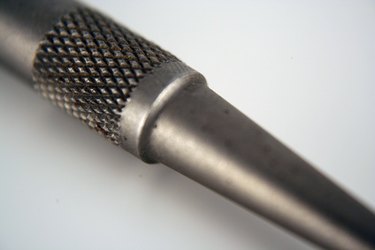Things You'll Need
Drill
Drill bit
Nail or metal punch

A common use of rivets is to fasten thin materials together, such as sheet metal or plastic. It is often impractical or undesirable to screw thin materials together because they can be pulled apart easily. Rivets supply a cap and pressure to both sides to provide holding power. Drilling out a rivet is a simple process that usually takes less than a minute, unless your rivet is large and solid. In such cases, do not worry. They also can be drilled out.
Aluminum Rivets
Step 1

Choose a drill bit the same size as the shaft of the rivet and insert it into the drill. The bit size need not be as large as the head of the rivet itself.
Video of the Day
Step 2
Position the drill bit on the head of the rivet and continue to drill until the head falls off.
Step 3

Remove the remains of the rivet with a nail set.
Solid Rivets
Video of the Day
Step 1
Choose a drill bit the same size as the shaft of the rivet and insert it into the drill.
Step 2
Position the drill bit on the head of the rivet and continue to drill until the head is removed. If you are unable to center the drill bit on the head of the rivet, use a sharp punch to dimple the center point. If the head will not disappear from drilling, you may need to use a larger bit. If you must install a new rivet, be careful not to over-size the hole.
Step 3
Hammer out the remaining part of the rivet with a metal or nail punch. Support the backside if there is a possibility of denting the surface.